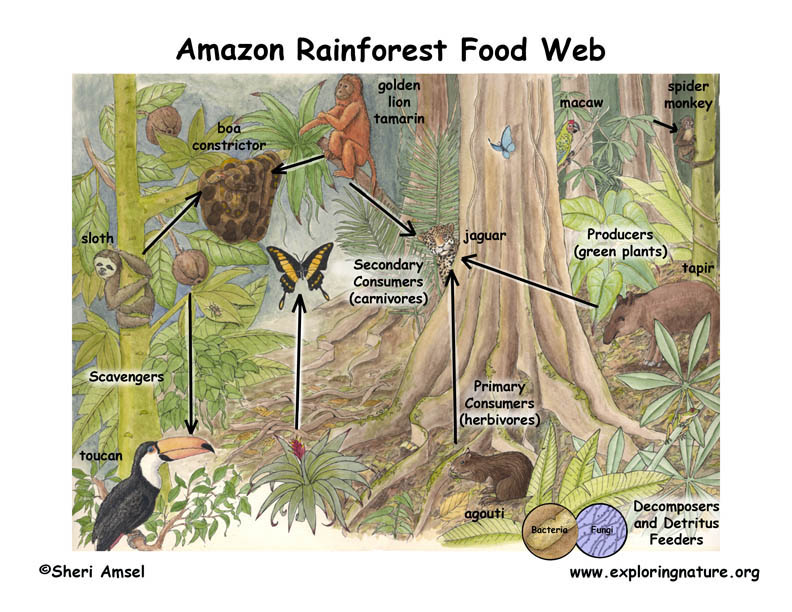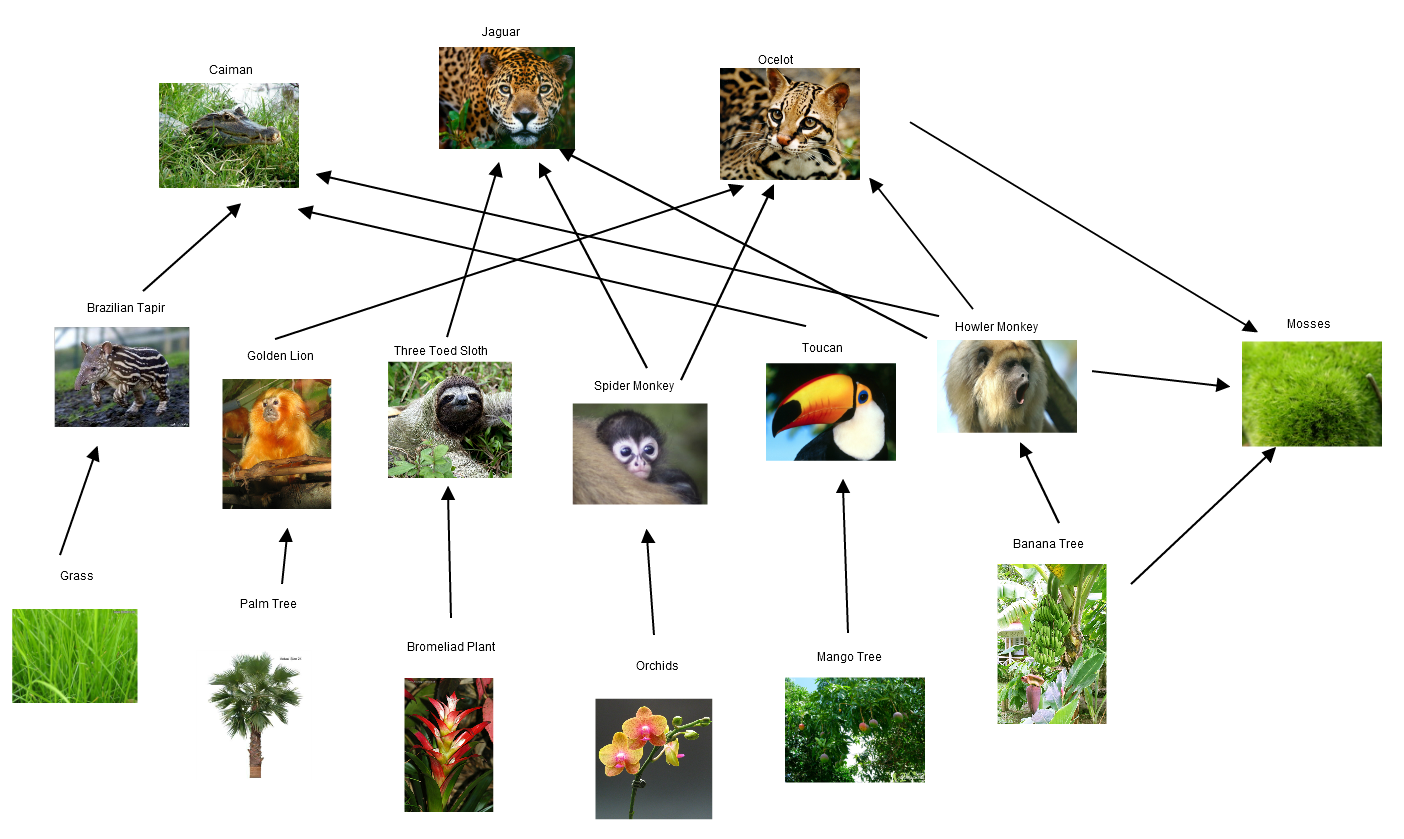Embark on a journey into the heart of the Amazon rainforest food web, a complex and interconnected system teeming with life. From the towering canopy to the teeming forest floor, this vibrant ecosystem showcases the intricate relationships between organisms, shaping the very fabric of the rainforest.
Within this verdant expanse, primary producers like towering trees and lush vegetation harness sunlight to create the foundation of the food web. Diverse consumers, from tiny insects to majestic jaguars, occupy various trophic levels, transferring energy and nutrients throughout the ecosystem.
Overview of the Amazon Rainforest Food Web
A food web is a complex network of interconnected food chains within an ecosystem. It illustrates the feeding relationships between different species, highlighting who eats whom and how energy flows through the system.
The Amazon rainforest, renowned for its immense biodiversity, serves as a prime example of a vibrant food web. This vast and intricate ecosystem supports an astonishing array of organisms, from towering trees to microscopic microorganisms.
Diversity of Organisms in the Amazon Rainforest
The Amazon rainforest harbors an unparalleled diversity of life forms. This includes:
- Over 40,000 plant species, representing more than 10% of the world’s known flora
- Approximately 3,000 freshwater fish species, constituting nearly 10% of the world’s total
- More than 1,000 bird species, representing about 20% of the global total
- A vast array of mammals, reptiles, amphibians, and insects, with many species yet to be discovered
Producers and Consumers in the Food Web

The Amazon rainforest is home to a vast and complex food web, with a wide range of producers and consumers interacting to sustain the ecosystem. Understanding the roles of these organisms is crucial for comprehending the intricate balance of this vibrant ecosystem.
Primary Producers
The primary producers in the Amazon rainforest are plants, which convert sunlight into energy through photosynthesis. These plants form the foundation of the food web, providing sustenance for all other organisms.
- Trees:Towering trees, such as kapok and mahogany, dominate the rainforest canopy and produce vast amounts of leaves and fruits.
- Shrubs and Vines:Smaller plants, including shrubs and vines, thrive in the understory and contribute to the overall plant biomass.
- Epiphytes:Plants that grow on other plants, such as orchids and bromeliads, contribute to the diverse plant life.
Consumers
Consumers in the Amazon rainforest rely on producers for sustenance. They can be classified into different trophic levels based on their feeding habits.
Herbivores
Herbivores feed directly on plants. Examples include:
- Tapirs:Large mammals that consume fruits, leaves, and buds.
- Macaws:Colorful parrots that feed on nuts and seeds.
Carnivores
Carnivores feed on other animals. Examples include:
- Jaguars:Powerful predators that hunt tapirs, monkeys, and other animals.
- Anacondas:Giant snakes that constrict and consume prey.
Omnivores
Omnivores feed on both plants and animals. Examples include:
- Peccary:Pig-like mammals that consume fruits, nuts, and insects.
- Toucans:Tropical birds that eat fruits, insects, and small animals.
Decomposers
Decomposers break down dead plants and animals, returning nutrients to the soil. Examples include:
- Fungi:Organisms that break down organic matter.
- Bacteria:Microorganisms that assist in the decomposition process.
Trophic Levels and Energy Flow
The food web in the Amazon rainforest is organized into trophic levels, with each level representing a step in the transfer of energy from producers to consumers. Energy flows from the primary producers (plants) to the primary consumers (herbivores), then to the secondary consumers (carnivores), and so on.
As energy is transferred, it is lost through heat and other processes, resulting in a decrease in energy available at each higher trophic level.
Interactions and Relationships: Amazon Rainforest Food Web

The Amazon rainforest food web is a complex and interconnected system where organisms interact and depend on each other for survival. These interactions include symbiotic relationships, predator-prey dynamics, and competition and cooperation.
Symbiotic Relationships, Amazon rainforest food web
Symbiotic relationships are mutually beneficial interactions between different species. One common example in the Amazon rainforest is the relationship between ants and acacia trees. Ants protect acacia trees from herbivores by attacking and deterring them. In return, the trees provide ants with shelter and food in the form of nectar and protein-rich structures called Beltian bodies.
Another example of symbiosis is the relationship between fungi and plants. Mycorrhizal fungi form symbiotic associations with plant roots, helping them absorb nutrients from the soil in exchange for carbohydrates.
Predators and Prey
Predators and prey play a crucial role in maintaining the balance of the ecosystem. Predators, such as jaguars and harpy eagles, control the populations of their prey, preventing overpopulation. Prey species, such as monkeys and rodents, provide food for predators and help regulate the availability of resources.
Competition and Cooperation
Competition and cooperation are essential forces that shape species interactions. Competition occurs when organisms compete for limited resources, such as food, water, or shelter. This competition can drive evolution and adaptation, as species develop strategies to outcompete their rivals.
Cooperation, on the other hand, occurs when organisms work together for mutual benefit. For example, mixed-species flocks of birds can improve their foraging efficiency by combining their different skills and knowledge of the environment.
Human Impacts on the Food Web
Human activities have a profound impact on the Amazon rainforest food web, both directly and indirectly. These impacts can have far-reaching consequences for the entire ecosystem.
One of the most significant human impacts is deforestation, which is the clearing of forests for various purposes such as logging, agriculture, and mining. Deforestation not only destroys the habitat of numerous species but also disrupts the food chain by eliminating food sources and altering the availability of resources.
Pollution
Pollution from human activities, such as industrial waste and agricultural runoff, can also have detrimental effects on the food web. Pollutants can accumulate in the environment and enter the food chain, affecting the health and reproduction of organisms at various trophic levels.
Climate Change
Climate change is another major human-induced impact on the Amazon rainforest food web. Changes in temperature, precipitation patterns, and sea levels can disrupt the distribution and abundance of species, leading to shifts in food availability and competition.
Conservation Efforts
Recognizing the importance of preserving the integrity of the Amazon rainforest food web, conservation efforts are underway to mitigate human impacts. These efforts include:
- Protected areas: Establishing and maintaining protected areas, such as national parks and reserves, helps to safeguard habitats and species from deforestation and other human disturbances.
- Sustainable land use practices: Promoting sustainable agriculture and forestry practices can reduce deforestation and pollution, thereby preserving the integrity of the food web.
- Research and monitoring: Ongoing research and monitoring programs help to assess the impacts of human activities on the food web and inform conservation strategies.
Data and Research

Data and research are crucial for understanding the dynamics of the Amazon rainforest food web. Scientists have employed various methods to study this complex ecosystem, including field observations, camera traps, and remote sensing technologies.
The following table summarizes key data and statistics related to the Amazon rainforest food web:
| Characteristic | Data |
|---|---|
| Number of plant species | 40,000+ |
| Number of animal species | 10% of the world’s known species |
| Number of bird species | 1,300+ |
| Number of mammal species | 378 |
| Number of fish species | 3,000+ |
Methods for Studying the Food Web
Scientists use a variety of methods to study the Amazon rainforest food web. These include:
- Field observations: Scientists conduct field observations to directly observe interactions between species.
- Camera traps: Camera traps are used to capture images of animals, providing insights into their behavior and feeding habits.
- Remote sensing technologies: Remote sensing technologies, such as satellite imagery and lidar, provide data on vegetation cover, canopy structure, and other environmental factors that influence the food web.
Areas for Further Research
While significant progress has been made in understanding the Amazon rainforest food web, there are still areas where further research is needed. These include:
- The role of keystone species in maintaining ecosystem stability.
- The impact of climate change on the food web.
- The effects of deforestation and other human activities on food web dynamics.
FAQ Section
What is the role of primary producers in the Amazon rainforest food web?
Primary producers, such as trees and plants, convert sunlight into energy through photosynthesis, providing the foundation for the entire food web.
How do predators and prey interact within the food web?
Predators play a vital role in controlling prey populations, maintaining ecosystem balance. Prey species, in turn, influence predator behavior and distribution.
What are the major threats to the Amazon rainforest food web?
Deforestation, pollution, and climate change pose significant threats to the delicate balance of the Amazon rainforest food web, disrupting species interactions and ecosystem dynamics.

